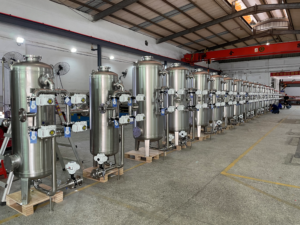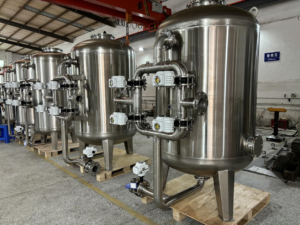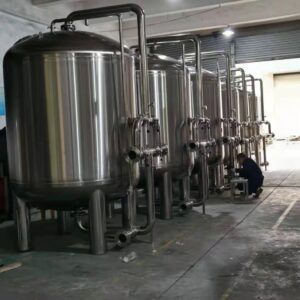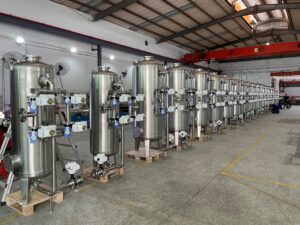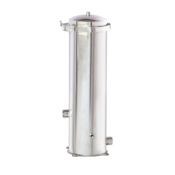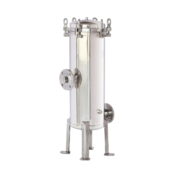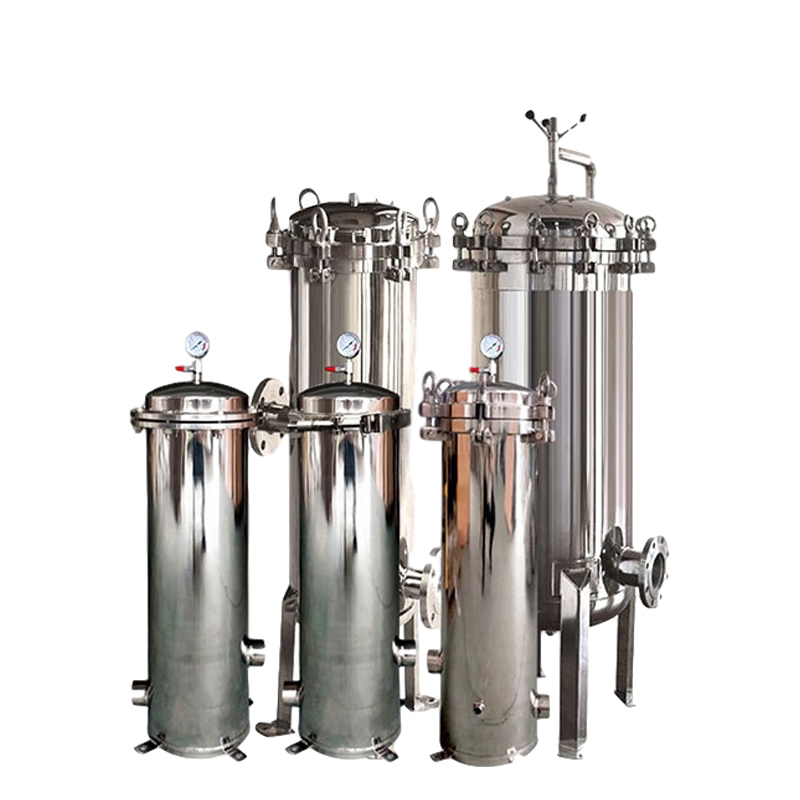Stainless steel Multimedia mechanical filter use for automatic sand filter, active carbon, quartz sand filter in water treatment plant
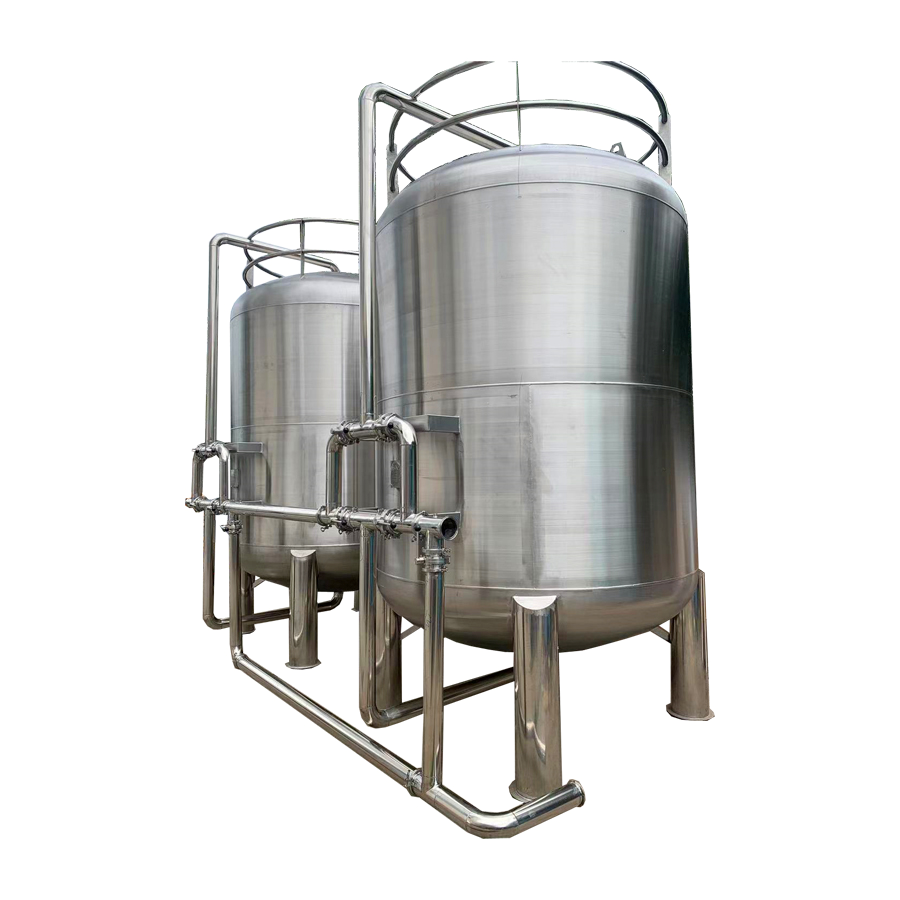
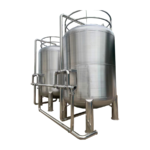
Stainless steel Multimedia mechanical filter use for automatic sand filter, active carbon, quartz sand filter in water treatment plant
Multi-media filters can be divided into mechanical filters and activated carbon filters. Used to remove suspended solids and mechanica impurities in water, and can be used for softening. Desalination Electrodialysis. Pretreatment of reverse osmosis system, treatment of surface water such as rivers and lakes, and coagulation equipment can be used to treat industrial water supply and domestic water. Activated carbon filters can also be used for further purification of tap water to remove on trace organic matter such as taste, color, phenol and some heavy metal ions, improve the quality of drinking water
1. Multi-media Filters Overview
1.1 Definition and Function
Multi-media filters are sophisticated water treatment systems designed to remove suspended solids and mechanical impurities from water. They play a crucial role in producing clean and safe water by trapping and removing contaminants such as silt, clay, grit, organic matter, algae, and other microorganisms. The functionality of multi-media filters extends beyond basic filtration; they can also contribute to water softening by reducing the concentration of certain ions.
These filters are particularly effective in industrial applications where high water quality is essential. They are used in desalination processes, electrodialysis, and as a pretreatment step in reverse osmosis systems. By removing larger particles and suspended solids, multi-media filters extend the life of more delicate filtration membranes and reduce the frequency of maintenance required for these systems.
In surface water treatment, such as in rivers and lakes, multi-media filters are indispensable. They help in reducing the turbidity and improving the overall quality of water, making it suitable for further treatment or direct use. The integration of coagulation equipment with multi-media filters enhances their performance, as coagulants help in clumping smaller particles into larger flocs that can be more easily removed by the filter media.
1.2 Types of Multi-media Filters
Multi-media filters can be categorized into two main types: mechanical filters and activated carbon filters, each serving different purposes in water treatment processes.
Mechanical Multi-media Filters are composed of layers of different media, such as sand, gravel, and anthracite, which are effective in removing a wide range of particle sizes. The multi-layered approach allows for the capture of larger particles near the top of the filter bed and smaller particles deeper within the media. This results in a more efficient use of the filter media and longer operation cycles between backwashing events. Mechanical filters are typically used for their ability to reduce turbidity, suspended solids, and certain contaminants from water streams.
Activated Carbon Multi-media Filters incorporate activated carbon as the primary media, which is known for its high adsorption capacity. In addition to removing suspended solids, activated carbon filters are used to absorb trace organic matter, such as taste and odor-causing compounds, phenols, and some heavy metal ions. This makes them ideal for the further purification of tap water, improving the aesthetic qualities and safety of drinking water. The activated carbon’s porous structure provides a large surface area for adsorption, making it highly effective for the removal of a broad spectrum of organic contaminants.
In summary, multi-media filters offer a versatile and efficient solution for water treatment across various industries. Their ability to remove contaminants and improve water quality makes them an essential component in ensuring the safety and quality of water supplies.
2. Mechanical Filters
2.1 Purpose and Applications
Mechanical filters are designed to remove suspended solids and mechanical impurities from water, making them ideal for applications where high water quality is paramount. These filters are widely used in various industries, including:
- Industrial Water Treatment: Mechanical filters are employed to remove particulate matter from industrial process water, ensuring that the water used in manufacturing processes meets the required purity standards.
- Municipal Water Supply: In municipal water treatment plants, these filters help in purifying water by reducing turbidity and removing contaminants that could otherwise pose health risks.
- Desalination Plants: Mechanical filters serve as a pretreatment step in desalination processes, removing larger particles that could foul the desalination membranes and reduce their effectiveness.
- Aquaculture and Irrigation: In aquaculture, mechanical filters maintain water quality by removing suspended solids that could harm aquatic life. Similarly, in irrigation systems, they help prevent the clogging of sprinklers and nozzles.
2.2 Working Principle
The working principle of mechanical filters revolves around the use of physical media to trap and retain contaminants. The filters are composed of multiple layers of media with varying sizes, typically including sand, gravel, and anthracite. Water flows through these layers, and particles are captured based on their size:
- Large Particles
- Smaller Particles
- Fluidization and Backwashing: To maintain the filters’ efficiency, a backwashing process is employed. This process fluidizes the media, expanding the bed and allowing the release of captured particles, which are then removed from the system.
The multi-layered design of mechanical filters allows for a graded removal of particles, with each layer targeting a specific size range. This results in a more efficient use of the filter media and extended periods between cleaning cycles.
2.3 Advantages and Maintenance
Mechanical filters offer several advantages in water treatment applications:
- High Filtration Efficiency: The multi-layered design ensures that a broad range of particle sizes is effectively removed, leading to cleaner output water.
- Long Operation Cycles: Due to the large surface area provided by the layered media, mechanical filters can operate for extended periods before requiring backwashing.
- Cost-Effective: These filters are relatively inexpensive to install and maintain, making them a cost-effective solution for water treatment.
However, regular maintenance is crucial for the optimal performance of mechanical filters. This includes:
- Backwashing: Periodic backwashing is necessary to prevent the media from becoming clogged with captured particles. This process also helps to extend the life of the filter media.
- Media Replacement: Over time, the filter media can degrade or become less effective. Regular inspection and replacement of the media ensure continuous performance.
- Preventative Maintenance: Regular inspections and maintenance can help identify and address potential issues before they lead to system failures or reduced water quality.
In conclusion, mechanical filters are a vital component in the water treatment process, providing a physical barrier to suspended solids and mechanical impurities. Their versatility and effectiveness make them suitable for a wide range of applications, from industrial processes to municipal water supplies. Proper maintenance and care ensure their longevity and efficiency in improving water quality.
3. Activated Carbon Filters
3.1 Role in Water Purification
Activated carbon filters are pivotal in water purification due to their adsorptive properties. They are designed to remove a wide range of contaminants, including trace organic matter, that conventional mechanical filters cannot effectively capture. The role of activated carbon filters in water purification is multifaceted:
- Adsorption of Organic Compounds: Activated carbon filters remove organic compounds responsible for taste, color, and odor in water. The porous structure of activated carbon provides a large surface area that can adsorb these compounds, improving the aesthetic quality of water.
- Removal of Harmful Substances: In addition to organic matter, activated carbon filters can capture phenols and certain heavy metal ions, which are known to be harmful to human health. This capability enhances the safety of drinking water by reducing the concentration of these contaminants.
- Refining Tap Water: Activated carbon filters are often used as a final step in tap water treatment processes to ensure that the water meets high standards for purity and safety. They provide an additional layer of purification beyond what mechanical filters can achieve.
3.2 Removal Capabilities
The removal capabilities of activated carbon filters are extensive and are a result of the activated carbon’s high adsorption capacity. Key contaminants that can be removed include:
- Trace Organic Matter: Activated carbon filters are effective in removing trace organic matter, such as pesticides, herbicides, and pharmaceuticals, which may be present in water even after primary treatment processes.
- Chlorine and Volatile Organic Compounds (VOCs): These filters can reduce or remove chlorine and VOCs, which are common contaminants in water supplies. The removal of these substances is crucial for improving the taste and odor of water.
- Heavy Metal Ions: Certain heavy metal ions, such as lead and mercury, can be adsorbed by activated carbon filters, reducing their concentration in the water to safe levels as defined by drinking water standards.
3.3 Application in Drinking Water Treatment
In drinking water treatment, activated carbon filters are applied as a critical step to ensure the quality and safety of the water supplied to consumers:
- Improvement of Aesthetic Qualities: By removing organic compounds that contribute to taste and odor, activated carbon filters enhance the aesthetic qualities of drinking water, making it more palatable for consumers.
- Compliance with Standards: The use of activated carbon filters helps water treatment plants meet strict regulations and standards for drinking water quality. They ensure that the water provided to the public is free from harmful contaminants.
- Protection of Public Health: The removal of harmful substances, such as heavy metals and organic pollutants, by activated carbon filters plays a vital role in protecting public health. It reduces the risk of waterborne diseases and long-term health issues associated with the consumption of contaminated water.
In conclusion, activated carbon filters are an essential component in the water treatment process, particularly for the purification of drinking water. Their ability to remove a broad spectrum of contaminants makes them a valuable tool in ensuring the safety and quality of water supplies. Regular maintenance and replacement of the activated carbon media are necessary to sustain their high removal capabilities and protect public health.
4. Water Treatment Processes
4.1 Desalination and Electrodialysis
Desalination and electrodialysis are critical processes in water treatment, particularly in regions where freshwater resources are scarce. Multi-media filters play a significant role in these processes.
Desalination involves the removal of salts and minerals from saline water, making it suitable for drinking and irrigation. Mechanical multi-media filters are often used as a pretreatment step in desalination to remove suspended solids and other impurities that could foul the desalination membranes. According to a study by the International Desalination Association, the use of pretreatment filters can increase the lifespan of reverse osmosis membranes by up to 30% and improve water recovery rates by 10-15%.
Electrodialysis is a process that uses an electric current to remove ions from water, making it a popular choice for brackish water treatment. Multi-media filters are essential in this process as well, as they help to reduce the concentration of suspended solids that could interfere with the ion exchange membranes. A report by the U.S. Bureau of Reclamation states that the use of multi-media filters can reduce membrane fouling by 50%, thereby reducing the frequency of cleaning and extending the life of the membranes.
4.2 Reverse Osmosis Pretreatment
Reverse osmosis (RO) is a membrane technology that removes ions, unwanted molecules, and larger particles from drinking water. The effectiveness of RO systems is highly dependent on the quality of the feed water, making pretreatment with multi-media filters crucial.
Multi-media filters serve as an essential pretreatment step by reducing the silt density index (SDI) and total suspended solids (TSS) in the feed water. A study published in the Journal of Membrane Science reported that using multi-media filters as pretreatment could reduce membrane fouling by 75% and increase the permeate flux by 20%. This not only extends the life of the RO membranes but also reduces the overall operational costs of the water treatment plant.
Moreover, multi-media filters can be combined with coagulation and flocculation processes to further enhance the removal of suspended particles. The addition of coagulants like aluminum sulfate or ferric chloride can help to aggregate smaller particles into larger flocs, which are more easily removed by the filter media.
4.3 Surface Water Treatment
Surface water, such as that from rivers and lakes, often contains high levels of suspended solids, organic matter, and microorganisms. Multi-media filters are indispensable in treating such water to make it suitable for drinking or agricultural use.
In surface water treatment, multi-media filters work by removing a broad range of particle sizes. The top layer of lighter media, such as anthracite, captures larger particles, while the denser media layers below, such as sand and gravel, remove smaller particles. This multi-layered approach results in a high removal efficiency, with studies showing that multi-media filters can achieve turbidity reductions of up to 99%.
Furthermore, multi-media filters can be integrated with other treatment processes, such as disinfection using ultraviolet (UV) light or chlorine, to provide a comprehensive treatment solution. For example, a study by the American Water Works Association found that combining multi-media filtration with UV disinfection can achieve over 99.99% removal of bacteria and viruses, ensuring the safety of the treated water for consumption.
In conclusion, multi-media filters are a vital component in various water treatment processes, including desalination, electrodialysis, reverse osmosis pretreatment, and surface water treatment. Their ability to remove suspended solids and mechanical impurities makes them essential for producing clean, safe, and high-quality water. Regular maintenance and optimization of these filters are crucial to ensure their ongoing effectiveness and efficiency in water treatment applications.
5. Industrial and Domestic Water Supply
5.1 Coagulation Equipment
Coagulation equipment is an integral part of water treatment processes, particularly in industrial applications where high water quality is essential. These systems use coagulants to aggregate smaller particles into larger flocs, which can then be more easily removed by subsequent filtration processes.
- Application in Industrial Water Treatment: In industries such as textiles, paper manufacturing, and food processing, coagulation equipment is used to remove suspended solids, color, and organic matter from process water. For instance, a study reported in the Journal of Environmental Management found that the use of coagulation equipment in the textile industry reduced suspended solids by over 80%, significantly improving water quality for reuse or discharge.
- Enhancement of Filtration Efficiency: Coagulation equipment works in tandem with multi-media filters to enhance their efficiency. By increasing the particle size through flocculation, coagulants ensure that the filter media is less likely to clog, thereby extending the time between backwashing cycles. This is crucial for maintaining continuous operations in industrial settings.
- Maintenance and Operation: Proper operation of coagulation equipment requires careful control of coagulant dosage and pH levels. Excessive coagulant use can lead to increased sludge production and higher operational costs. Regular monitoring and adjustment of these parameters are essential to optimize the coagulation process and ensure effective water treatment.
5.2 Treatment of Industrial Water
Industrial water treatment demands a high level of purification to meet the strict quality standards required for various processes. Multi-media filters, particularly mechanical filters, play a pivotal role in this treatment.
- Removal of Suspended Solids: Industrial water often contains suspended solids that can interfere with processes such as heat exchange, chemical reactions, and material finishing. Mechanical multi-media filters effectively remove these solids, with studies showing a reduction of turbidity by up to 95%, as reported in the International Journal of Environmental Science and Technology.
- Scale and Corrosion Control: In addition to particulate removal, industrial water treatment may also involve the use of inhibitors to control scale and corrosion. Multi-media filters can be designed to incorporate these inhibitors, further enhancing water quality and protecting industrial equipment from damage.
- Customized Solutions: The specific requirements of different industries may call for customized filter designs. For example, the pharmaceutical industry may require filters with a higher degree of bacteria removal, while the cooling tower water in power plants may need a focus on scale prevention. Multi-media filters can be tailored to meet these specific needs, ensuring optimal water quality for each application.
5.3 Domestic Water Purification
Domestic water purification aims to provide safe and aesthetically pleasing water for household use. Activated carbon filters are often employed in this context to remove trace organic matter and improve water quality.
- Removal of Taste and Odor: Activated carbon filters are highly effective at removing compounds responsible for taste and odor issues in drinking water. According to a study published in Water Research, activated carbon filters can reduce trihalomethanes (THMs), a common taste and odor issue, by over 90%.
- Phenol and Heavy Metal Ions Removal: Beyond improving taste and odor, activated carbon filters also play a critical role in removing phenol and heavy metal ions, which can have serious health implications. A report by the World Health Organization (WHO) highlights that activated carbon filters can reduce lead concentrations to below the recommended limit of 10 µg/L.
- Combination with Other Treatments: For optimal domestic water purification, activated carbon filters are often used in conjunction with other treatments such as sedimentation, coagulation, and disinfection. This multi-barrier approach ensures that water is free from a wide range of contaminants, providing households with safe and high-quality drinking water.
In conclusion, coagulation equipment and multi-media filters are essential components in both industrial and domestic water treatment processes. Their ability to remove suspended solids, organic matter, and other contaminants ensures that water quality meets the required standards for a variety of uses. Regular maintenance and optimization of these systems are crucial for their ongoing effectiveness and efficiency in improving water quality.
| Model | Flow rate T/H | Specification | Sand kg | Sand + carbon kg | Resin L |
| STK-MMF-325 | 0.8-1.2 | 325*1700*1.5MM | 150 | 50+25 | 70 |
| STK-MMF-350 | 1.2-1.8 | 350*1760*1.5MM | 170 | 50+50 | 85 |
| STK-MMF-400 | 1.3-2.0 | 400*1800*1.5MM | 200 | 50+50 | 100 |
| STK-MMF-450 | 1.5-2.5 | 450*1860*1.5MM | 250 | 50+75 | 150 |
| STK-MMF-500 | 2.0-3.0 | 500*1900*1.5MM | 300 | 50+100 | 200 |
| STK-MMF-600 | 2.8-4.2 | 600*1950*1.5MM | 500 | 100+100 | 250 |
| STK-MMF-700 | 3.8-5.7 | 700*2000*1.5MM | 700 | 100+150 | 325 |
| STK-MMF-800 | 5.0-7.5 | 800*2050*1.5MM | 900 | 150+200 | 450 |
| STK-MMF-900 | 6.3-9.5 | 900*2050*1.5MM | 1.2T | 200+250 | 625 |
| STK-MMF-1000 | 7.9-11.9 | 1000*2500*3.0MM | 1.4T | 300+300 | 800 |
| STK-MMF-1200 | 11.3-16.9 | 1200*2650*3.0MM | 2.4T | 400+450 | 1130 |
| STK-MMF-1400 | 15.4-23.1 | 1400*2750*3.0MM | 3.3T | 500+625 | 1530 |
| STK-MMF-1500 | 17.7-26.5 | 1500*2750*3.0MM | 3.8T | 600+700 | 2250 |
| STK-MMF-1600 | 20.1-30.1 | 1600*2800*3.0MM | 4.3T | 600+800 | 2500 |
| STK-MMF-1700 | 22.7-34.0 | 1700*2850*3.0MM | 4.9T | 700+900 | 2900 |
| STK-MMF-1800 | 25.4-38.1 | 1800*3000*3.0MM | 5.5T | 700+1000 | 3300 |
| STK-MMF-1900 | 28.0-42.0 | 1900*3050*3.0MM | 6.1T | 800+1100 | 3700 |
| STK-MMF-2000 | 31.0-47.0 | 2000*3300*4.0MM | 6.8T | 1000+1250 | 4000 |

